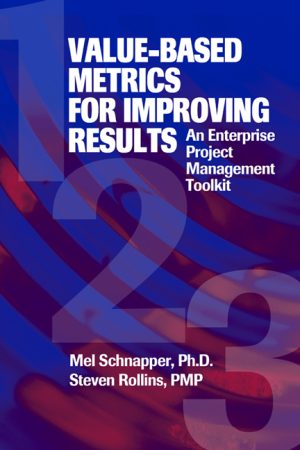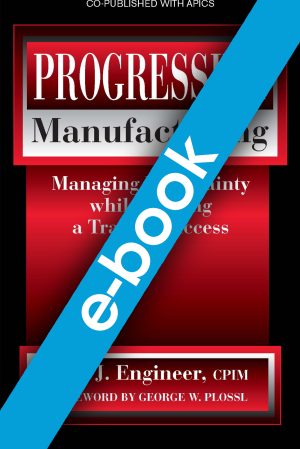Progressive Manufacturing
$39.95
Managing Uncertainty While Blazing a Trail to Success
By Soli J. Engineer
Hardcover, 6×9, 272 pages
ISBN: 1-932159-29-0
February 2005
APICS
Description
Manufacturers are continuously searching for solutions to their seemingly never-ending inventory, delivery, cost, productivity, quality, and profit woes. Progressive Manufacturing: Managing Uncertainty While Blazing a Trail to Success provides powerful, cutting-edge, common-sense solutions to these and other perennial problems faced by most organizations. The book delineates the three keystones essential to achieving any significant degree of success — people, products or services, and processes. It presents thought-provoking ideas and methods for simplifying processes at every level.
Author Soli Engineer explores topics that are instrumental to achieving success, but are often avoided, such as work breakdown structure and improvement curve theory, and explains “how to” and “how not to” approaches to production and inventory management. This book provides innovative techniques that take you beyond the tried and true to achieve real operational success and increased profits. It is a must-read for operations, production, and supply chain professionals.
Key Features
- Challenges unfounded comparisons between MRP (a procedure) and JIT, Kanban, and TQM (philosophies)
- Clarifies a key interface between engineering and manufacturing — the Product Data Management (PDM) system
- Provides innovative methods for using bills of material to improve productivity and multiple ways to reduce lead times and inventory
- Emphasizes the vital ingredients for achieving success and the dangers of ignoring one or more of them
- WAV offers free downloadable cost roll-up exercises, learning and improvement curve tools, and PowerPoint slides describing how to effectively establish and achieve improvement objectives — available from the Web Added Value™ Download Resource Center
About the author(s)
Soli J. Engineer is a management consultant and the sole proprietor of SJE Consultants & Associates. He offers more than 25 years of management, global business, and manufacturing experience and is a member of the American Production & Inventory Control Society (APICS) and Certified in Production and Inventory Management (CPIM). He has taught several certification courses and is a sought-after speaker and published author.
Table of Content
Section I: People
Chapter 1: Change — The Biggest Hurdle!
A Professional Rut
For Whom Do You Work?
Types of Changes
Leadership and Teamwork
Cause for Concern
What Does It Take to Effect Change?
Management’s and Employees’ Responsibility
Chapter 2: Organization
Keep It Shallow
Mission
Credo of the Organization
Right People in the Right Jobs
Motivation
Incentives and Intra-Company Competition
Performance Evaluations
Fear
The Real Objective
Chapter 3: My Five C’s
Care
Comprehension
Commitment
Communication
Common Sense
Section II: Products and Services
Chapter 4: Product Design
Bills of Material
Work Breakdown Structure
Streamlining the Procurement Effort
Can Bills of Material Help with Outsourcing the Finished Product?
Establishing a “Statement of Work” for Each Supplier
Managing “Free-Issued” Components to Suppliers
Changes and Corrections to Bills of Material
Chapter 5: Inventory
How Much Is Enough?
Types of Inventory
Why Carry Inventory?
Daily Cycle Counts
Chapter 6: Lead Times
Components of Lead Time
Purchasing, Manufacturing, and Administrative Lead Time
Pull and Issue Components from Stock
Purchase Requisition Approval
Stocking Parts and Finished Goods
Minimizing Administrative Lead Times
Minimizing Traditionally Accepted Components of Lead Times
Setup, Wait, and Move Time
Chapter 7: Product Cost
Costing Methods
Cost Elements
Purchased and Manufactured Components
Product Pricing
Improvement Curve Theory
Continuity
Role of Improvement Curves in Pricing
Supply Chain Management
Section III: Processes
Chapter 8: Quality
ISO Certification
Continuous Improvement: Processes
Understanding and Managing Process Variations
Process Evolution — Thanks to Technology
Chapter 9: Engineering Processes
Design Systems
Product Data Management Systems
Repository for Engineering Information
Data Library
Engineering Change Management
Buffer Between Engineering and Manufacturing Data
Examples
System Compatibility and Interfaces
Data Transfers Between PDM and Business Systems
Establishing a Workflow: The Manual System
Chapter 10: Manufacturing Processes
Planning Processes
Business Planning
Sales and Production Planning
Master Schedule
Capacity Requirements and Shop Floor Scheduling
Material Requirements
Execution Processes
Issuing Work Orders
Issuing Purchase Orders
Inventory Management
Other Processes
Reporting Processes
Chapter 11: Manufacturing Philosophies
A Bit of History
The Basic Requirements
“Push” Versus “Pull” Systems
Work Order or Kanban?
Have We Come Full Circle?
Effect on Our Industry
What Really Makes JIT, Kanban, and TQM Different?
Section IV: The Future
Chapter 12: Where Do We Go from Here?
The Traditional Tool Kit
One Size Does Not Fit All
Cherry-Picking Is Not a Good Idea
One of My Experiences
Appendix A
Cost Roll-up (Example)
Improvement Curves
Computing the Slope
Appendix B
The Logic of MRP
Inputs to MRP
Output of MRP
The MRP Process
Generating a Material Requirement Plan
Bibliography
Index
Reviews
“Unlike other books on industrial planning and control, this one contains a wealth of information on the people factor — the most important of the three elements required for success in any commercial business. This book will be useful to people at all levels of the organization in manufacturing and distribution businesses.”
– From the foreword by industry pioneer George W. Plossl
You may also like…
Related products
-

Essential Project Investment Governance and Reporting
Retail Price: $59.95$49.95 Add to cart -

Value-Based Metrics for Improving Results
Retail Price: $54.95$49.95 Add to cart -

Managing Business Analysis Services
Retail Price: $54.95$44.95 Add to cart -

Achieving Inventory Accuracy
Retail Price: $49.95$44.95 Add to cart -

Quantitative Methods in Project Management
Retail Price: $64.95$59.95 Add to cart


